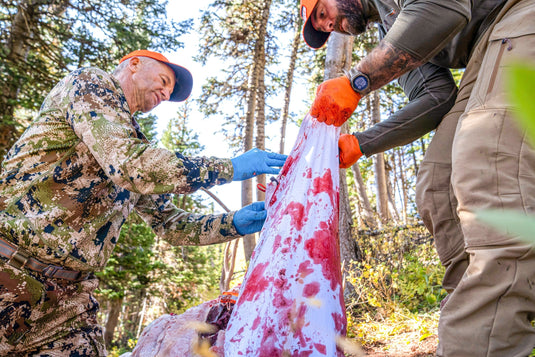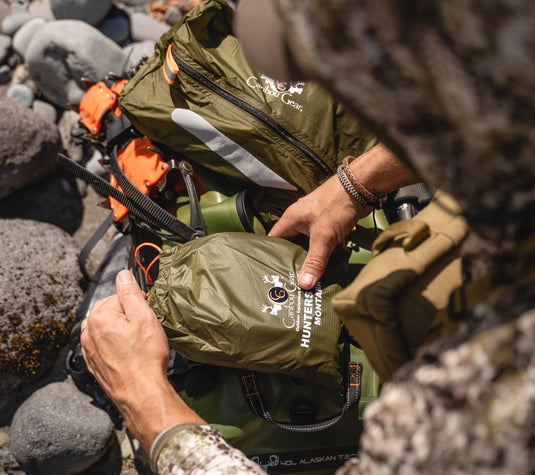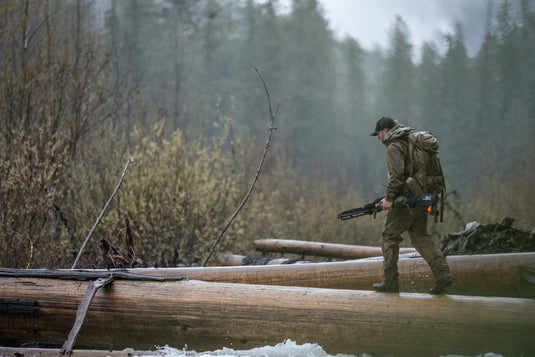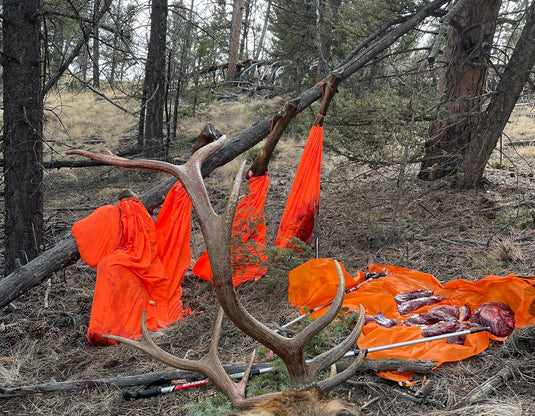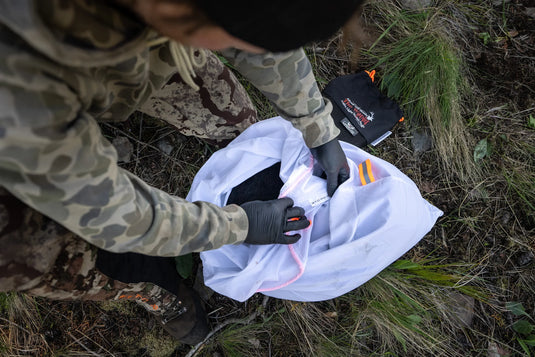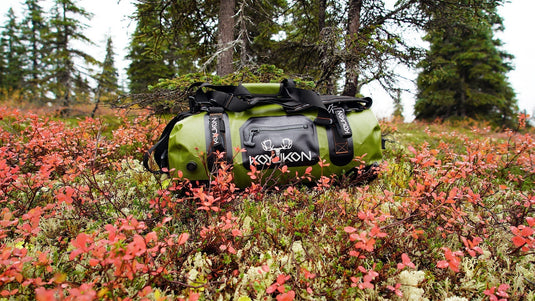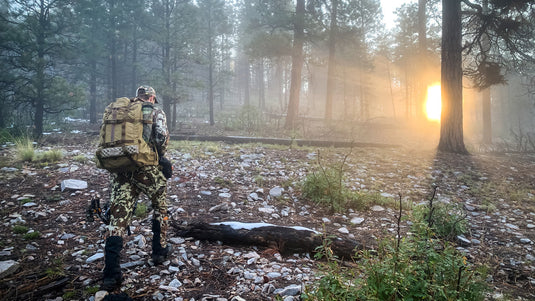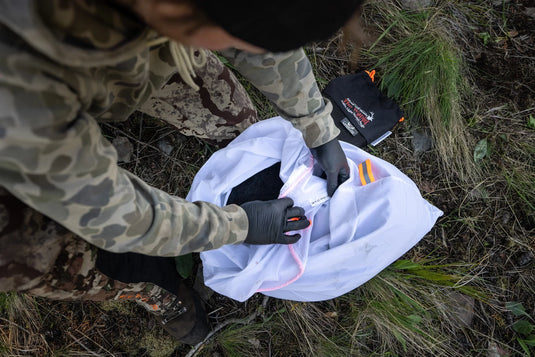

Playing it safe in bear country is a deliberate procedure. It's not something we are wired to think about, being a lower link in the food chain. But once you get there, whether by vehicle, horseback, hike, or bush plane, you know
and feel it when you leave your ride behind, or the bush plane fades into the distant sky.
The silence is deafening. You are aware of how quiet it is yet how loud the smallest of noises can be. You then realize you're on your own with your senses in full-throttle mode.
The bear that charged me on a hunt years ago was in an area thick with trees and underbrush, surrounded by shallow water from endless rain. I was hunting moose using a bow. I had just set up with a bow in hand and an arrow nocked and began making moose grunts and cow calls within seconds of finishing the first sequence of calls.
I suddenly heard a loud swishing sound to my right. As I turned, I saw not the moose I was hoping for but a big black blur, splashing water like a hurricane wind heading right for me!
I dropped my bow and picked up my backup rifle, which I had leaning against a tree, within arms reach. The bear was now at 10 yards. I raised the rifle halfway to my shoulder, all the while screaming, "Bear, bear, bear!" The bear suddenly slid to a stop, and as fast as it came in, it turned and ran.
Yes, it was a heart-stopping experience, and I was very lucky. Then I realized that the rifle only made it halfway to my shoulder, and I did not have a chance to aim before the bear reached me. In hindsight, reaching for my sidearm would have been best. I believe the bear and likely bear cubs just happened to cross our path as we had been standing there for at least an hour. We never know what we may encounter while hunting outdoors, so it is always best to be prepared.
How to Prepare Months Before Your Hunt
Months before we leave home, we cover many topics in our hunt preparation

meetings, including the possibility of a bear encounter. We cover camp safety along with who leads when heading into confined underbrush the pathway of big and small game, mainly bear. There are many details to go over, such as how the lead man covers our forward path, left and right. Depending on how many hunters you may have in your group, you would walk single file with each individual watching left and right, with the hunter in the back covering left and right and behind him. This procedure is in play just in case a bear charged. We do this so we do not have a cross-fire situation and everyone knows what is expected of them. Remember that no one knows how they will react in such a situation until it happens.
Mentally and Physically Preparing for Your Hunt
Mentally prepare by imagining yourself in that situation and asking yourself what to do first. Keep your head and mindset in protecting yourself and those around you.

Physically prepare by thoroughly knowing your handgun, as this will likely be your last line of defense; if time and distance permit, use your rifle. Learn to hold and shoot properly. Target practice often! With an empty chamber, ensure you have a good solid stance, that your finger finds its place to the trigger, and that your hands are firmly gripped with arms extended and locked. You're working on muscle memory.
What Handgun Do I Use

Know your limits regarding the size and caliber you can handle. I use a snub-nosed 2 1/2-inch barrel 454 Casull, Super Redhawk Alaskan Revolver. In the same revolver, you can use 45 Long Colt ammo. I have also carried a 44 mag, which is lighter in weight and impact. I use the 454 because it's what I
 can still physically handle for now.
can still physically handle for now. For ammo, I use Buffalo Bore 300-360 grain or Grizzly ammo, a leather Diamond D chest holster, and sometimes a hip holster. The hip holster can be difficult to reach, and the chest holster can get in the way. I'll use my chest holster on a day in the thick underbrush.
For many years, I carried a 6-inch barreled 454 until the weight started taking a toll on my wrist. I have practiced shooting my 454 single-handed, and I don't recommend it; this is a two-hand gun. I have single-handedly fired the handgun several times. But I also had it twist my wrist and grip, cutting the inner portion of my thumb with the trigger.
I suggest a revolver for simplicity, and as far as caliber is concerned, make sure it is one you can handle. It's more shot placement, and the bullet impact a mad bear will go until it can't!
I believe I could make all six single-handed shots with the 454 in a life-and-death situation and an adrenaline overload, but I'm not too sure I'd hit the target.
Revolver versus a semi-auto handgun, well, more lead down range for sure! But I have had my semi-auto be more prone to jamming. Hunting can be wet, dusty, and dirty. Not to mention the fast reload and fire. In a fear-crazed moment in an attack situation, a person would probably not know their finger is on the trigger, sending the bullets flying somewhere. I trust a basic and deliberate revolver when hunting in brown bear country.
Strengthen your wrist and target practice often.
Note: I carry a Kimber micro 9mm in a small hip holster when hunting the lower forty-eight.
Bear Spray
In all the years, I have never taken bear spray to bear country simply because a commercial flight into the bush is not legally permitted. Some bush plane pilots will have it for rent or sale or may be available at the village general store. Which do you reach for when a bear decides to charge?
Electric Fence
I have never taken an electric bear fence hunting anywhere. That is not to say it won’t work if it is constantly maintained. On one occasion, my good buddy insisted on taking a bear fence, only to have it short out, using all his batteries in a few days due to the constant rain. But the fence remained for the duration because of a sense of security and the exercise we got stepping over it;)
A Bear Free Camp
There is no such thing as a bear-free camp. Bears are intelligent animals; they know you're there. But, like all of us, the temptation can be overwhelming. If you tempted them with the smell of food around camp, in your tent, in your backpack, blood on your pant leg, and yes, this includes toothpaste, chewing tobacco, and scented chapstick, you are asking for trouble.

Your tent is only for sleeping! All scented items should be hung up in a tree, out of bear's reach.
Pee around camp, but **it in the woods, at least 50 yards away from the tent, “buried,” and opposite from where you walk to the water or the camp cook station. Use plastic ziplock-type bags to contain feminine products. When convenient, burn in the daily fire and wash under clothing as needed.
Brush your teeth and spit in the fire or a few feet in the river. This will dilute the scent of toothpaste and flow downstream away from camp.
Camp Cook Station
Find a comfortable location with shade, level ground, trees, and, if possible, a place with a huntable view. Make a tarp shelter for frequent rainy days where you can eat without getting wet. This is where you’ll also make your fire to burn all scented food packaging. (See the Montana Tarp)
Hang Your Food and Scented Items

Find a location in a cluster of trees within view of your cook station. This is where you’ll hang your food in roll-top bags after every use. See our tried and true method of this procedure using The Hanger. Hanging your food is a must! Imagine if you were to hunt all day, only to come back and find that a bear consumed and destroyed all food and scented items. It happens, so don’t take a chance, or your hunt is over! PDF - Hanging System

The image above: The scarecrow, a T-shirt and plastic bag below hanging food bags.
Game Meat Pole
Your meat pole can be located a short distance from your cook station and within view. Once you nocked or shot that monster of a moose, your work has just begun. Meat care is a crucial, time-consuming procedure (extended meat care is another topic that will soon be written).
But for bear safety, it’s essential to do the following with game meat around camp or not!
The Scent of Man
The man part is in a general term; the point is, as humans, we stink!As mentioned above, we cannot hide from bears; while visiting their domain, look around, and you will see signs everywhere. But taking every precaution to keep them at bay is a part of maintaining a safe camp.

Pee around the perimeter of your camp area. Around the base of trees or shrubs, in a place where you or others won't step in. Around the perimeter of the cook station and meat pole area, place a well-worn scented t-shirt and a sock or two at eye level, tie the item, or hang them so they can freely move in the breeze.
The Scarecrow
You will want to add a 55-gallon plastic construction bag to the list of recommended items. Hang the bag by the top opening, and tie only what's needed to securely hang the bag, leaving the rest of the opening to catch the wind and breeze. This movement and sound will keep a curious bear out of camp. Over the years of hunting Alaska and the lower forty-eight, this setup has worked for me.

Note: In Alaska's vast landscape, there are bears that may have never seen a human and don’t know to fear us. The lower forty-eight hunting pressure can keep some bears in hiding for most of the hunting season. It still doesn’t mean to be complacent.
Don’t be lazy or lax when hunting, fishing, or camping in bear country.


